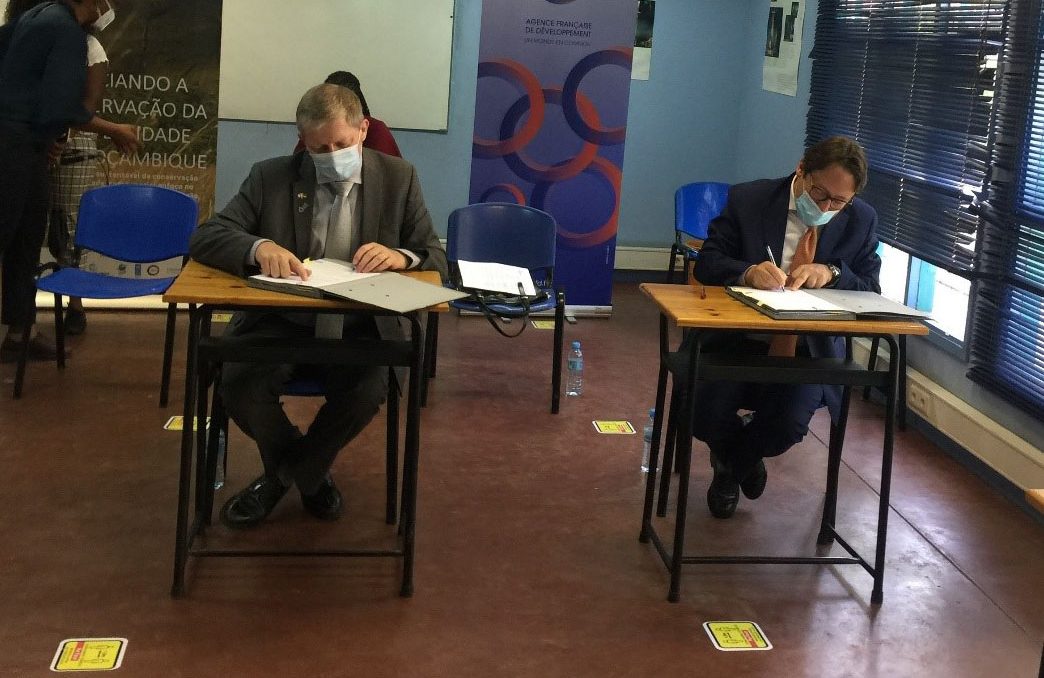
AFD & BIOFUND Create An Endowment On Climate Disasters
On March 3 2021, a financing agreement was signed between the French Development Agency (AFD) and the Foundation for the Conservation of Biodiversity (BIOFUND) for the project designated Organizing Nature-based Response and Solutions for Natural Disaster Risk Reduction (ECO-DRR). This is a project with the aim of strengthening ecosystem, community and financial resilience, in the face of climate change in Mozambique.
Emergencies are a fact of life, in conservation as in other sectors. These emergencies are increasingly climate-related, such as the case of floods, droughts, and particularly extreme weather events such as cyclones, as was clear in the twin cyclone events Idai and Kenneth in Mozambique in 2019. Idai washed away many of the river crossings in Chimanimani National Reserve, as well as some of its infrastructures at Reserve headquarters. Kenneth, in turn, destroyed several of the Ranger posts in the Quirimbas National Park. Events such as these generally occur with little to no advance warning and have highly unpredictable impacts when they do occur. What we do know is that climate change has made extreme events more likely, more frequent and more intense.
To date, BIOFUND has not had access to ready capital in these circumstances and has only been able to reorganize some funding commitments to make room for emergency contributions. Following the 2019 disasters, for example, in coordination with project MozBio2 (supported by IDA/World Bank), BIOFUND was able to contribute with $250,000 to the reconstruction of Chimanimani access roads. This not only took time for the necessary approvals to occur but was also insufficient for the needs.
It is in this context that BIOFUND proposed to create a specific emergency fund to be used to respond in a timely manner when such catastrophes occur throughout the protected area network. This has been accepted as part of the ECO-DRR project signed with the French Development Agency (AFD), which will contribute the first 2M euros (approx. 2.4M USD) to this fund.
The emergency fund capital will be invested as part of BIOFUND’s main endowment, and not be separated out in any physical manner, in order to benefit from the economies of scale that an approximately 50-million-dollar endowment fund can achieve. The specific revenues of this emergency endowment will be re-invested each year and not fund the regular annual contributions to the protected areas in the country. This will build up a pool of capital specific for emergency response.
The criteria for receiving funding will be based on damage from extraordinary events, such as could not be prevented by good management practices. For example, damage from normal wear and tear or lack of adequate maintenance would not be eligible. Normally, an extreme external event such as a flood, cyclone, major uncontrolled fire, or something similar would be the trigger for eligibility. Damages sustained would also need to be above the protected area’s ability to respond with their normal maintenance budget.
Under the current investment policy, the endowment contribution of 2.4 million USD to the proposed Emergency Fund could therefore be expected to sustainably generate just over 70.000 USD each year. If a catastrophic event is expected every 5 years, then this fund would be able to contribute about 350.000 dollars to recovery efforts from each event.
This is likely to be insufficient to respond adequately. It is therefore very important to highlight that this fund can also work as an aggregator for additional donations that are sourced in the response to any specific emergency event, providing a reliable and trustworthy channel to rapidly move resources to where they are most needed. Obviously, any additional endowment contributions could also be used to contribute to the emergency response as needed.
With this new tool, BIOFUND and AFD will help ensure that the Conservation Areas have timely access to funds to respond to the destruction and damage caused by natural disasters.

